Basil is among the favorite herbs of all time due to its unique taste and aroma. Like other plants, basil is also prone to bacterial and fungal disease and pest infestation causing black spots.
Many gardeners find it hard to treat the black spots on basil since they can’t seem to pinpoint if it’s caused by a pest, a disease, or temperature changes.
In this post, we’ll help you identify the cause of black spots on your basil plants and how to treat them.
We’ll also share commonly asked questions like eating basil with spots. First, let’s get to the bottom of things and find out what’s damaging your favorite pesto ingredient!
(You could use the table of contents below to jump to the sections that are most important to you.)
Identifying The Culprits Behind The Black Spots on Basil
With the effects of insects and fungal diseases in basil plants, it can be tricky to identify the causes.
The problem with not identifying the right cause is not preventing the progression of the damage on time and also wasting money on the wrong solutions.
To help you find the right solution, here are four possible causes of black spots in basil plants.
#1 Blotch Leaf Miners
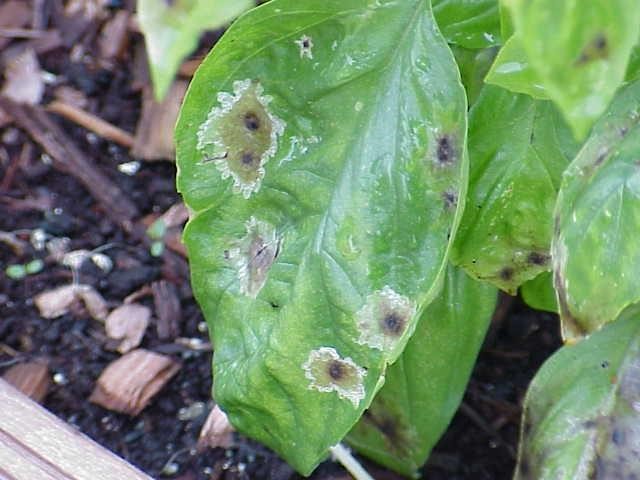
Leafminers are popular for leaving maze-like feeding trails on leaves. However, that is the damage from a serpentine leaf miner.
What most gardeners are yet to discover is the type of leaf miner that causes black spots on leaves or the blotch leaf miner.
Most of the time, blotch leaf miner infestation is mistaken as a fungal disease since the resemblance is uncanny.
The signs that a blotch leafminer is feeding on your basil plant are the big black spots inside a white ring. The black spots are caused by the larvae of leaf miners living inside the leaf itself.
Adult blotch leaf miners lay their eggs either on the underside of the leaves or inside the leaves.
As soon as the eggs hatch the larvae will start feeding on the cell membranes of the leaves and begin to show damage.
The black spot is where the larvae are feeding which grows as they continue to feed on the plant cell membranes.
You can remove an infected leaf and cut the outer layer of the infected area to see the feeding larvae of blotch leaf miners. While blotch leaf miners don’t pose a big threat to plants.
However, when it comes to basil leaves that we consume and add to our meals, you’ll need to do some pest control. We’ll discuss the solutions for this case later in this post.
#2 Bacterial Disease
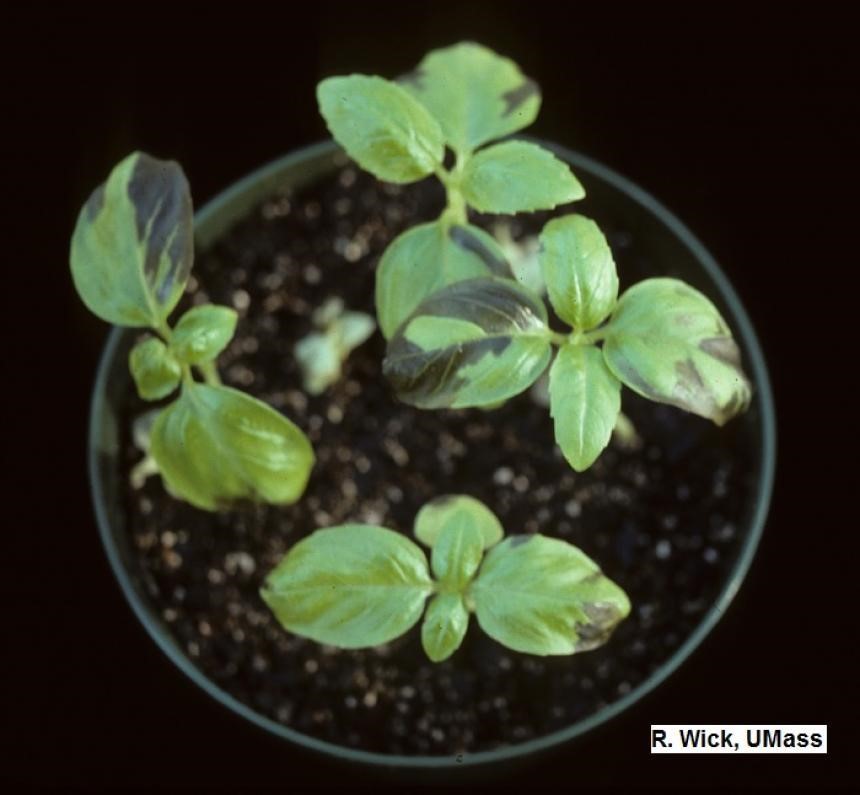
Pseudomonas cichorii is a bacterial disease developed due to too much nitrogen in the soil and drenching basil leaves with water. It spreads through the spores transferred to water splashes and rain.
So it’s a possible impact when you over-fertilize your basil plants and water them through their foliage.
The signs of bacterial disease on basil plants are when the black spots start to dry out and become holes on the leaf.
You need to remove the infected leaves to prevent the bacteria from spreading throughout the plant.
#3 Fungal Diseases
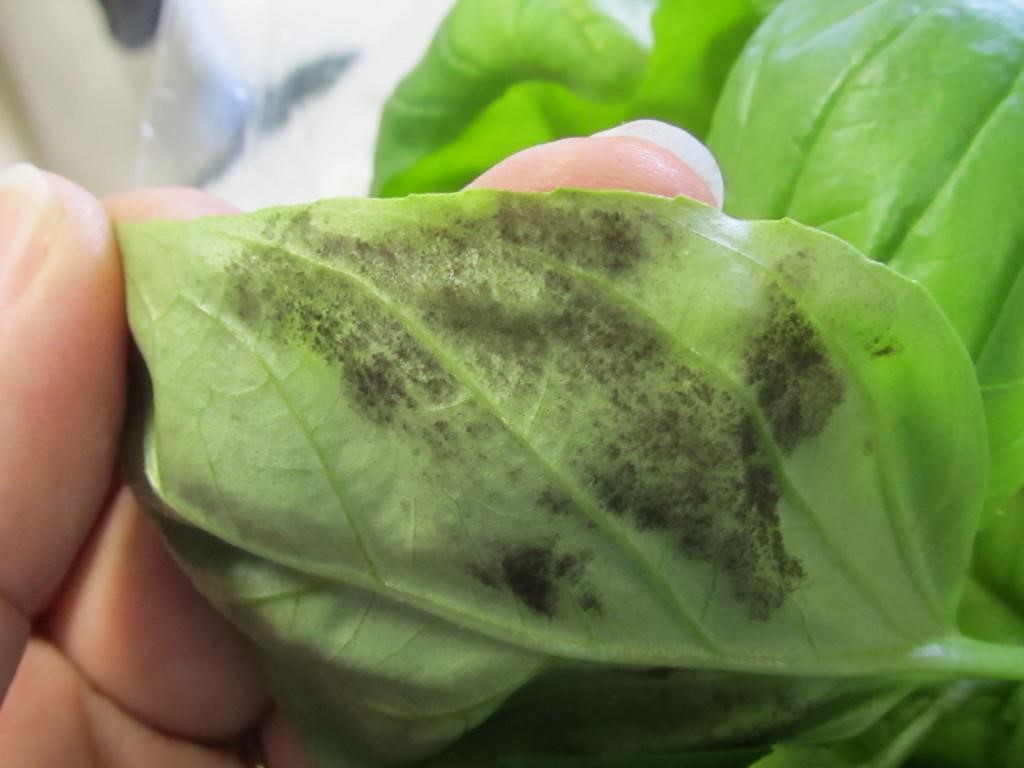
Downy mildew is a common cause of black spots in sweet basil due to the host-pathogen Peronospora belbahrii.
The disease starts on the underside of the leaves as specks of grey. The spots will initially look fluffy and somehow detached from the leaves.
As the disease progresses, yellow blotches will start to appear and brown and dark spores start to spread from the underside of the leaves.
In severe cases of a plant infection, the plant can die. This plant disease thrives in warm, moist, and humid conditions which are the type of weather that the basil plants love.
The spores of downy mildew are spread by wind, water splashes, and contamination of plant tools. It is among the common diseases that affect sweet basil production in different countries due to crop loss.
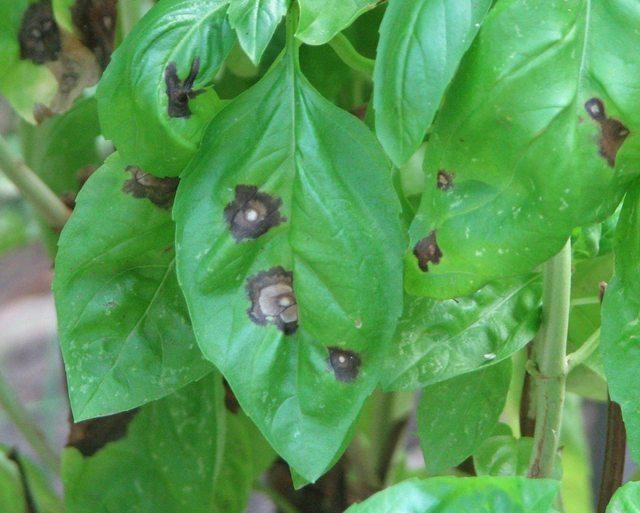
Another disease that can attack your basil plants is the Cercospora leaf spot. It is also a common disease in sweet basil caused by Cescospora ocimicola.
The sign of this disease is when you see a dark spot with a light center. It also thrives in a moist and humid environment and can overwinter in the soil.
The spore of this plant disease also spread through contaminated materials, wind, and water splashes.
Severe cases of Cercospora leaf spot can kill your basil plants and waste all of their beautiful and delicious leaves.
If not detected early, this disease can spread like wildfire on your other plants as it is also a common disease in tomato plants and other fruits and vegetables.
#4 Temperature Changes
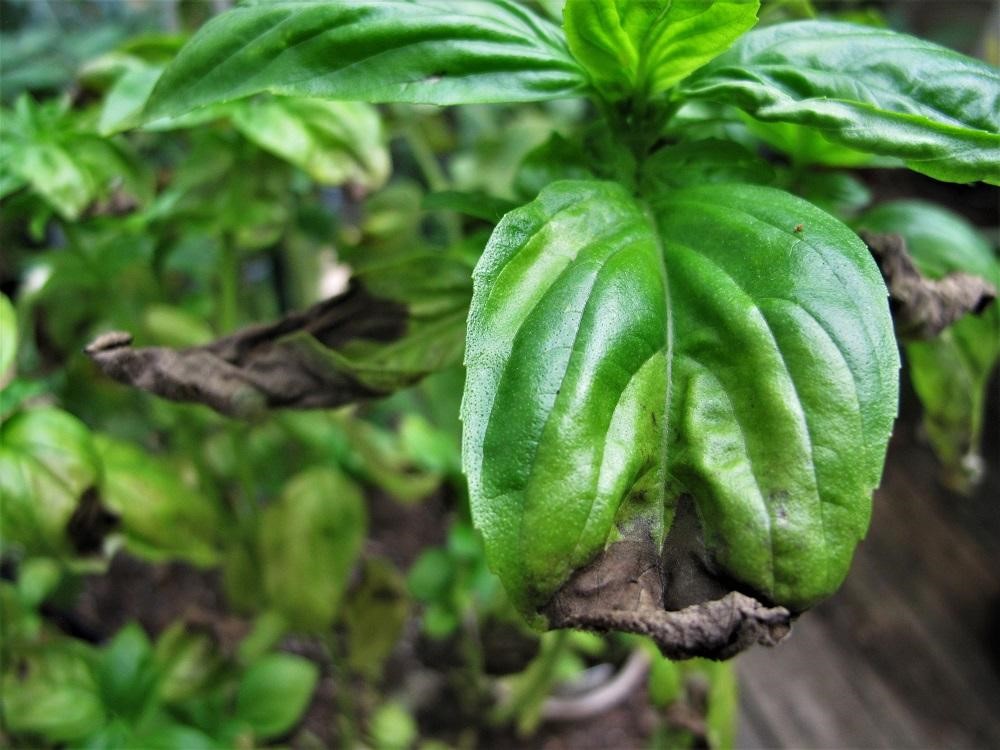
Basil seedlings suffer the most when it comes to subfreezing temperatures. Basil plants grow and thrive in warm environments and cold temperatures can kill them. Basil seedlings, in particular, are not strong enough to endure temperature changes.
The minimum temperature for basil must be above 50 degrees Fahrenheit since it is a tropical plant. Anything that goes beyond that can put your plants at risk.
The sides of the leaves will start to turn black and spread black spots throughout the leaves. When all of the leaves turn black, your basil plant will start to wilt and die.
How To Treat The Black Spots on Basil?
If you were able to identify the culprit of black spots on basil leaves based on the causes mentioned above, it will be easier for you to pick the right solution to your problem.
It takes a consistent plant care routine and monitoring to keep the pests and diseases at bay.
Here’s how you can save your precious basil leaves:
Dealing With The Blotch Leaf Miners in Basil
The dark spots from these pests happen when they are successful in laying their eggs on the basil leaves.
So, the goal is not to let these insects get near your basil plants or at least eliminate them in your garden.
Here are the steps that you can try:
1. Remove the infected leaves
Once the leaf miners damage your basil, it will never recover and get back to its green glory. So, it is best to remove the affected leaves and prevent the larvae from feeding on your plants.
Use clean shears and dip them in soapy water to prevent the spread of diseases or any microscopic pathogens on your plants.
2. Remove visible eggs
There is no better way in controlling insects than physically removing them from the leaves.
While you can use a commercial insecticide to do the insect control, you may also opt for a simple homemade solution like soapy water. It’s a non-toxic solution and easy to prepare.
Dip a soft cloth into a dish soap solution and wipe the basil leaves to get rid of the eggs and larvae.
Do this for two to three consecutive days to help control the number of leaf miners in your garden.
3. Use sticky traps
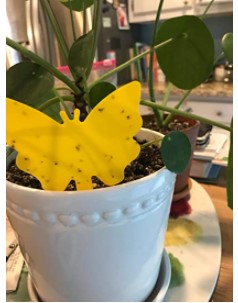
Adult blotch leaf miners look like black flies that roam around plants where they can lay their eggs.
You can prevent that from happening by putting some sticky traps on your basil plants. This is effective as a monitoring strategy when you finish cleaning off the infected leaves.
4. Protect your basil plants with row covers
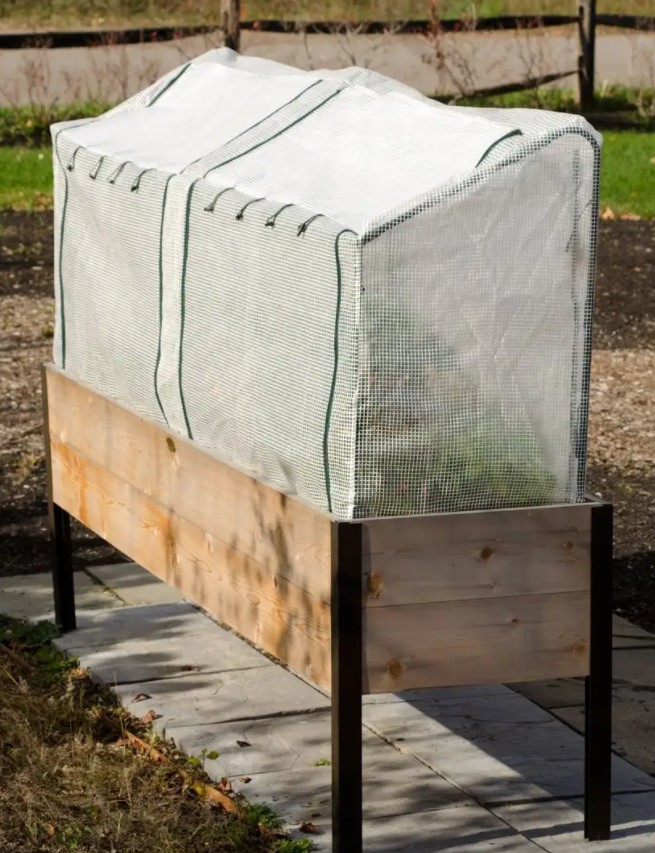
Row covers are effective in preventing any insects and worms from damaging your plants. It is usually made of a mesh net which is breathable enough for herbs to grow underneath it.
This is a cost-effective and non-toxic solution for controlling pests in your garden.
Dealing With Bacterial And Fungal Disease in Basil
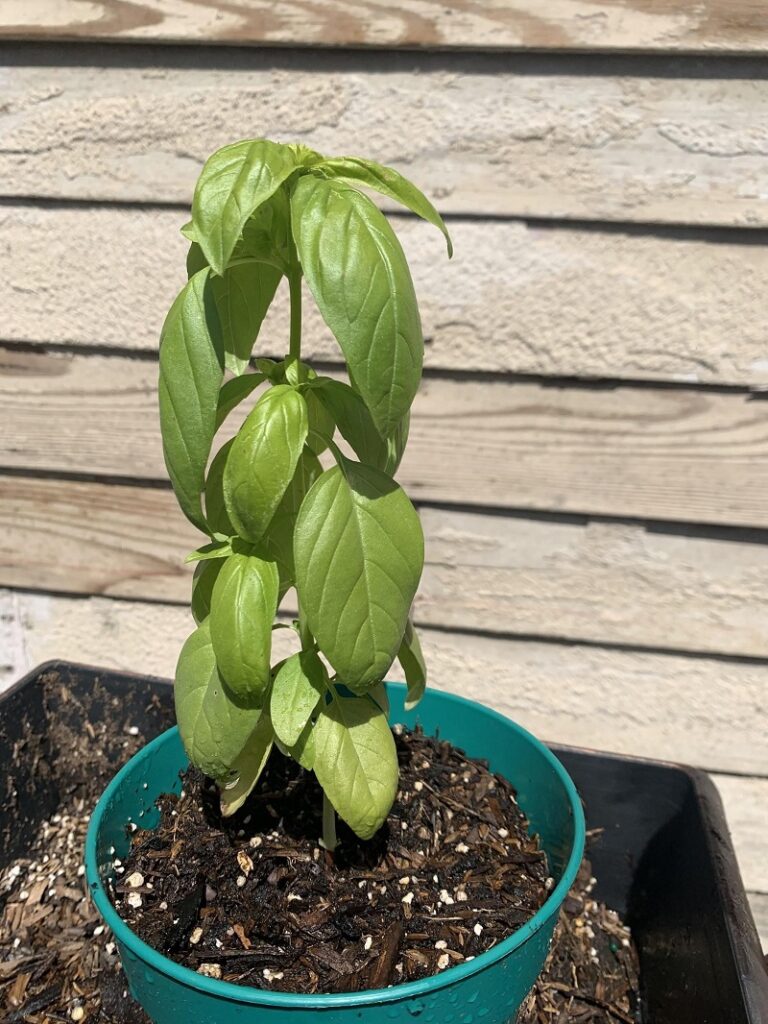
The wind and other carriers of pathogens can spread the spores of downy mildew and bacterial diseases on your basil plants.
These plant diseases are easy to spread and can put your basil plants in a state that is beyond saving. So, the earlier you detect the signs of fungal and bacterial infection, the better for your plants. You can treat them by:
1. Remove the infected basil leaves
Before you start treating a fungal or bacterial disease in plants, you must remove all infected parts to prevent the spores from spreading.
Mix a dish soap solution to dip your shears whenever you cut a leaf or stem. Also, make sure to wash your hands before touching healthy leaves and stems
2. Apply mulch
The fungus that causes Cercospora leaf spot and bacteria can overwinter in the soil. Mulch prevents the lower leaves from touching the soil and covers the ground from preventing water splashes from spreading spores.
What’s more, mulch also keeps weeds at bay.
4. Water plants through soil drench
Avoid watering your plants from the leaves as it creates a perfect environment for the spores to thrive in.
Wet leaves in a humid environment make it easier for plant diseases to develop and damage your basil plants until they start to wilt and die.
5. Use fungicide and bactericide
The most recommended natural fungicide for Cercospora leaf spot and downy mildew is a copper fungicide.
You can also count on neem oil since it works as a contact insecticide, fungicide, and miticide. However, bactericides in the market can only do so much. You should keep trimming the infected parts.
Dealing With Black Spots Due To Temperature Changes in Basil
Basil is sensitive to humidity levels, especially the seedlings grown indoors.
If you want to bring your basil outdoors for the growing season, you should expose your basil plants to the outside temperatures slowly.
Especially during spring, basil may tend to be shocked by the sudden temperature change and start to look droopy.
Start taking out your basil plants outside for 15 minutes and increase the exposure time until your basil gets well accustomed to the outdoor temperatures.
You might also like: 3 Possible Causes of White Spots On Basil Leaves & How To Treat Them
Frequently Asked Questions(FAQs)
Can you eat basil with black spots?
Though consuming basil leaves with black spots is safe, the taste can be different. They can taste bitter and slimy and might spoil your food if you mix it in.
Does basil droop at night?
Basil is sensitive to changes in temperature. At night, the temperature drops which triggers the basil to react and have droopy leaves.
Even in colder seasons, basil leaves will start to droop before showing black spots on their leaves.
What can you do with old basil?
You can use old basil on your classic pesto and add it to your favorite dips and sauces.
Some people prefer drying old basil leaves and crushing them for preservation to add them to meals as a condiment.
Can basil get too much sun?
Yes, The scorching afternoon sun can also overwhelm basil plants, especially their seedlings. The leaves will have some leaf burn and become droopy.
Even though basil loves the sun, they still need a partial shade in the afternoon.
How do I know when to pick basil?
Harvest basil leaves when they reach 6 to 8 inches height when the leaves are at their juiciest.
Better pick them up early in the morning and continue to harvest their leaves to encourage more foliage as they grow.
Will the leaf spot go away on its own?
No, bacterial and fungal leaf spot is highly contagious and doesn’t go away on its own. You must remove the infected parts and clean the tools that you used with soapy water.
Then, treat the plant with sulfur or copper-based fungicides by applying them weekly or bi-weekly, depending on the severity of the disease.
Final Thoughts
We hope that this post has been helpful to your quest in finding the culprit behind the black spots on your basil plants. It can be tricky to figure out what is harming your plants at first.
However, once you unveil the disease or the pest that’s feeding on your delicious basil plants, it will be easier to treat them.
If you find this post helpful, please don’t forget to share our post and help other gardeners treat their herbs.
Were you able to control the black spots on your basil plants? Share your experience in the comment section below!
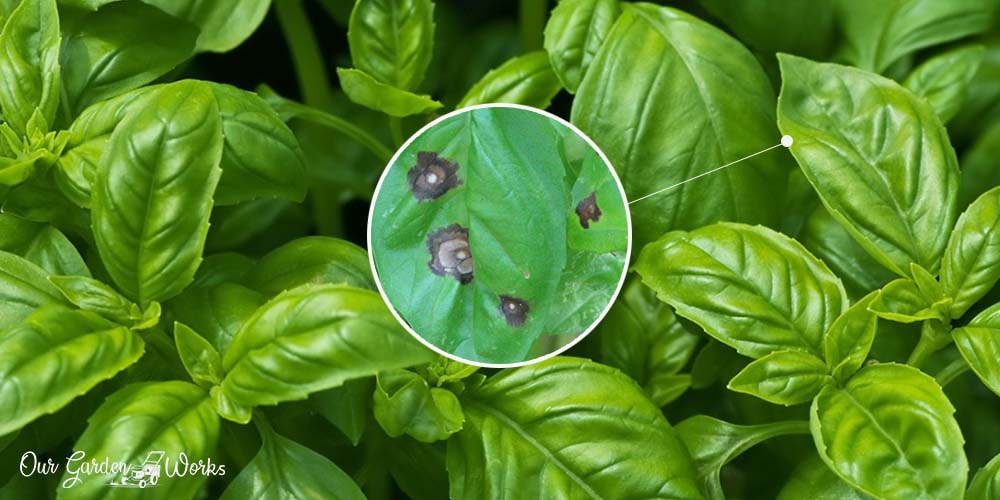
Great article! Very helpful to determine what was causing black spots on my lettuce leaf basil. Turns out, it’s due to the crazy temperature fluctuations in Wisconsin this year. Your close-up pictures were especially awesome, as most articles just have a written description and maybe a vague picture or two. Thank you for sharing this! 🙂
Thank you, Holly. Hope this helps!